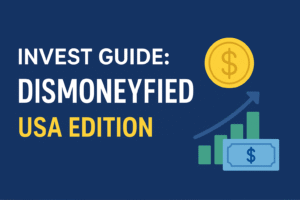Invest Guide Dismoneyfied USA Edition: Simple & Smart Investment Strategies for Americans
Introduction
Investing often feels complicated in the United States. There are hundreds of account types, thousands of funds, and endless advice that can leave you confused. The Dismoneyfied approach is about stripping all of that away and focusing only on what matters: clear goals, safe structures, and smart choices.
This Invest Guide: Dismoneyfied (USA Edition) explains how to make simple, reliable decisions about your money using officially available U.S. accounts, tax advantages, and investment products. By the end, you’ll understand how to set goals, choose accounts, build a portfolio, and stay on track for the future.
Define Your Goals Clearly
The first step in the Dismoneyfied method is knowing exactly why you’re investing. In the U.S., goals can be grouped into three categories:
- Short-Term Goals (1–3 years): Saving for a car, a vacation, or a home down payment. These require safe, liquid options like FDIC-insured savings accounts, Certificates of Deposit (CDs), or Treasury bills.
- Medium-Term Goals (3–10 years): Planning for college tuition, business investments, or a bigger home. Balanced investments such as bond funds, REITs, and index funds work well.
- Long-Term Goals (10+ years): Retirement, financial independence, or legacy planning. These benefit most from retirement accounts like 401(k)s, IRAs, and stock index funds.
By connecting your investments directly to your goals, you remove the guesswork.

Build Your Emergency Fund First
Before investing, you need security. An emergency fund ensures you don’t sell investments at the wrong time.
- Store 3–6 months of living expenses.
- Use FDIC-insured savings accounts, money market accounts, or short-term Treasury bills.
- Keep this money safe and liquid.
This is the foundation of the Dismoneyfied system: invest only after your safety net is secured.
Understand U.S. Investment Accounts
The United States provides specific account types, each with tax rules and benefits. Choosing the right account is as important as choosing the right investment.
- 401(k): An employer-sponsored retirement plan with tax deferrals and often a company match. Always take the match it’s free money.
- IRA (Traditional): Contributions may be tax-deductible; taxes are paid when withdrawing later.
- Roth IRA: Contributions are after-tax, but withdrawals in retirement are tax-free.
- Brokerage Account: A standard taxable account for flexibility with no contribution limits.
- 529 Plan: A tax-advantaged account for education savings.
- HSA (Health Savings Account): A triple-tax-advantaged account for medical expenses and long-term savings.
The Dismoneyfied principle: maximize retirement and tax-advantaged accounts before taxable brokerage.
Core Investment Options in the USA
Investing becomes easier once you know the main categories. A U.S.-based Dismoneyfied strategy should focus on these:
- Index Funds & ETFs
- Example: S&P 500 Index Fund or Total Stock Market ETF.
- Benefits: Low cost, broad exposure, long-term growth.
- U.S. Treasury Securities
- Treasury bills, notes, and bonds purchased via TreasuryDirect.gov.
- Safe, government-backed, and predictable.
- Bonds & Bond Funds
- Corporate bonds, municipal bonds, and government bond funds.
- Provide income and reduce volatility.
- Real Estate Investment Trusts (REITs)
- Allow exposure to real estate without owning property directly.
- Cash & Cash Equivalents
- High-yield savings, CDs, and money market accounts.
- Useful for stability and short-term goals.
The idea is simple: pick low-cost, diversified, official options instead of chasing risky trends.
Portfolio Models (USA Edition)
Here are sample portfolio mixes based on different investor types:
- Conservative (Low Risk):
60% U.S. bonds + 30% U.S. stock index funds + 10% cash. - Balanced (Moderate Risk):
50% U.S. stock index funds + 40% U.S. bonds + 10% REITs. - Aggressive (High Risk):
80% U.S. stock index funds + 10% international funds + 10% bonds.
You can adjust based on your goals and age, but the principle remains: diversify and keep it simple.
Taxes and Protections in the U.S.
The Dismoneyfied approach means understanding tax rules and protections that already exist:
- Capital Gains Tax: Profits from selling investments are taxed. Long-term gains (held over a year) are taxed at lower rates than short-term.
- Dividends Tax: Qualified dividends receive lower tax rates, while ordinary dividends are taxed as income.
- Retirement Accounts: Offer tax advantages to encourage saving. 401(k) and Traditional IRA defer taxes, while Roth IRA grows tax-free.
- FDIC Insurance: Protects deposits in banks up to $250,000 per depositor.
- SIPC Protection: Covers brokerage accounts up to $500,000, including $250,000 cash, in case of broker failure.
These official protections make the U.S. one of the safest places to build long-term wealth.
Practical Steps for U.S. Investors
To apply the Invest Guide: Dismoneyfied, follow these steps:
- Open an official account (401(k), IRA, or brokerage).
- Start with index funds broad, diversified, and low-cost.
- Automate contributions monthly so investing happens without thought.
- Keep costs low: look for expense ratios under 0.10%.
- Diversify across assets stocks, bonds, real estate, cash.
- Rebalance yearly to maintain your target portfolio.
Automation and consistency are key.
Mistakes to Avoid in the U.S.
Even with the Dismoneyfied approach, many investors lose money by falling into common traps:
- Cashing out retirement accounts early penalties and taxes erase gains.
- Ignoring employer match in a 401(k).
- Putting too much money in a single stock or cryptocurrency.
- Forgetting Required Minimum Distributions (RMDs) after age 73.
- Paying high advisory or management fees unnecessarily.
- Letting emotions drive decisions panic selling or chasing hype.
Avoiding these mistakes is as important as choosing the right investments.
Monitoring and Reviewing Your Plan
The Dismoneyfied method does not mean you invest and forget forever. You need a simple system to review:
- Annually: Check if your portfolio is still aligned with your goals.
- Rebalance: If stocks have grown too much compared to bonds, shift back.
- Life changes: Update goals after marriage, children, career moves, or approaching retirement.
- Stay updated: Follow official IRS contribution limits and updates to retirement accounts.
This keeps your plan relevant and strong over time.
Invest Guide Dismoneyfied USA Edition: Simple & Smart Investment Strategies for
Conclusion
The Invest Guide: Dismoneyfied (USA Edition) shows that you don’t need complexity to succeed in investing. By starting with an emergency fund, using official accounts like 401(k) and IRA, focusing on low-cost index funds, and diversifying across safe U.S. options, you can build long-term wealth.
The Dismoneyfied philosophy is simple: cut the noise, trust the proven systems, and stay patient. With this approach, any U.S. investor can secure their financial future without being overwhelmed.
FAQ: Invest Guide Dismoneyfied
Q1: What does Dismoneyfied mean in investing?
It means removing unnecessary complexity and focusing on clear, proven strategies for building wealth.
Q2: Should I invest if I still have debt?
Pay off high-interest debt (like credit cards) first. Low-interest debts (like student loans or mortgages) can often be managed while investing.
Q3: What’s the best first step for beginners in the U.S.?
Open a Roth IRA or 401(k) if available, and start investing in a low-cost index fund.
Q4: Is the stock market too risky for beginners?
Not if you use index funds, diversify, and stay invested for the long term. Short-term volatility is normal, but long-term growth is strong historically.
Q5: How much should I invest each month?
Start with what you can afford — even $100 monthly grows significantly over decades. Automating contributions makes it easier.
Q6: How do I know if my investments are safe?
Use FDIC-insured accounts for savings, SIPC-protected brokerages for investments, and choose established U.S. firms like Vanguard, Fidelity, or Schwab.














Post Comment